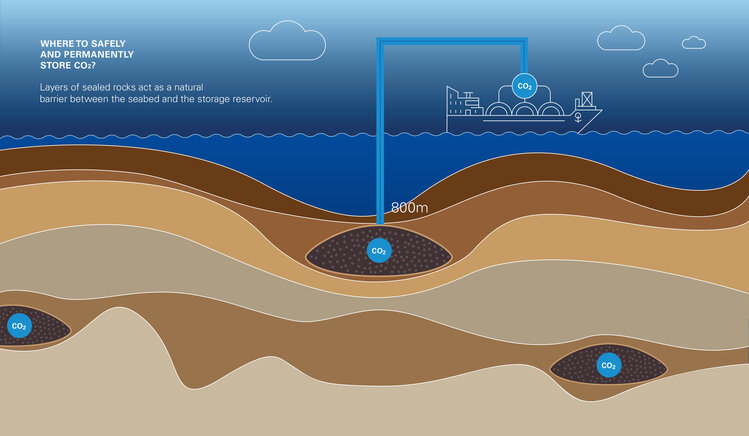
(OMW, 27.Jun.2023) — What if we could mitigate the effects of global warming by trapping greenhouse gases at their source and putting them deep underground so they never get into the atmosphere? Well, it turns out we can. The technology is called Carbon Capture and Storage (CCS). Olivier Point, geoscientist and senior project manager for CCS Solutions at OMV, explains how the method works and the role it plays in the energy transition.
“Put simply, the concept of Carbon Capture and Storage is to capture CO2 in the gas phase, liquefy it, transport it, and inject it into a reservoir in the ground where it can be stored safely and permanently”, says Olivier Point. Let’s take a closer look at each step.
Phase 1: How to capture CO2
“Capture is happening at what we call the post-combustion stage and has been done for decades now in refineries all over the world”, Olivier explains. For this, chemical compounds named amines are used to capture CO2 in a chemical reaction, one that can later be reversed to release the CO2 and reuse the amines”, Olivier says.
Phase 2: How to liquefy CO2
To process the extracted gas, it is brought down to a specific temperature and pressure to be liquefied. It is also dehydrated. “The infrastructure needed for Carbon Capture and Storage is a capture and processing plant next to the industry or plant that emits CO2”, Olivier says. It is then conveyed by a pipeline to a liquefaction unit where it is made ready to be further transported to a storage site. “Over the past few years, business models have changed and companies and industries that emit a lot of CO2 are coming together to elaborate industrial hubs where they can share the infrastructure for capturing and processing CO2 for more efficiency”, Olivier says.
Phase 3: How to transport CO2
After the gas has been extracted, collected, and processed, it can be conveniently transported by any means we know for transporting liquefied gases: Trucks, trains, barges, ships, vessels, or pipelines. “CO2 is no different from other liquefied gases, like ammonia or liquefied natural gas. Once liquefied, it can be transported over long distances”, Olivier explains.
Phase 4: How and where to store CO2
“When the CO2 gets injected, it is at the so-called dense phase, which means it has the viscosity of a gas and the density of a liquid”, Olivier explains. Experts like him try to find reservoirs to store the CO2 safely, permanently, and cost effectively. Currently, most of the storage reservoirs can be found in the North Sea and are evaluated by the UK, Norway, Denmark, and the Netherlands. The CO2 is stored in depths ranging from 800 to 2000 meters below the surface into rocks that are sealed.


Why is Carbon Capture and Storage an important technology?
The International Energy Agency’s net zero scenario targets involve CCS for 15% of the emissions reduction, that’s 7.5 billion tons per year by 2050. For Olivier, implementing the technology is not an option, but a necessity. “On the one hand, we cannot eliminate fossil fuels overnight, because energy demand is increasing. Goal 7 of the UN Sustainable Development Goals calls for an affordable, reliable and sustainable source of energy for all. So we still need fossil fuels during the energy transition. On the other hand, there are other industries that emit a lot of CO2 like the cement industry and the steel industry. We need solutions to handle these emissions and Carbon Capture and Storage is a great option.”
Pressed on whether CCS is a false hope because it is too capital intensive, Olivier counters: “It’s far from being a scam. Like most other renewable energies, it is very capital intensive; that’s a fact. But the thing we need to understand is that CCS is a necessity not an option. Additionally, governments are enabling innovative and technological advancements via investment policies. Everyone has net zero targets and CCS is essential in meeting them.”
Oliver Point also joined the OMV Podcast “Rethinking Resources” to talk about CCS. Watch the whole recording here:
____________________
